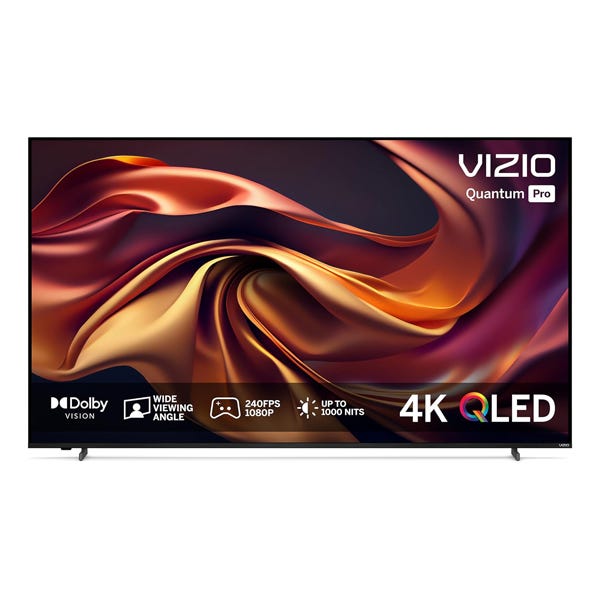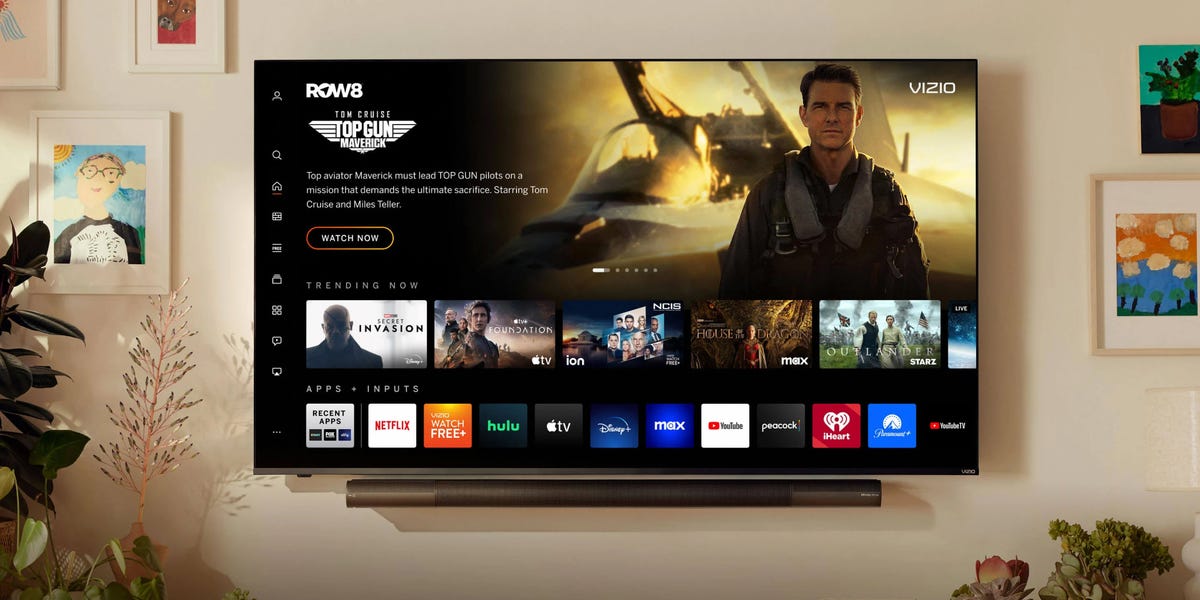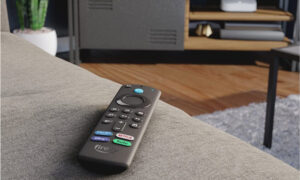When you buy through our links, Business Insider may earn an affiliate commission. Learn more
For years, Vizio ruled the value-TV roost, offering bang-for-your-buck performance that the competition simply couldn’t match. Then TCL and Hisense stepped in, crafting affordable TVs with killer picture quality and simple interfaces via partnerships with brands like Roku and Google. The fierce competition helped usher in a new era of high-quality home viewing on the cheap, and the upstarts became the value brands to beat.
Vizio would no doubt love to reclaim its spot, but the brand’s new Quantum Pro 4K QLED TV (VQP65C-84) won’t get it there. The display has a bright picture with quantum-dot colors, but it lacks the deep black levels and near-perfect local dimming that makes rivals like the Hisense U7K or TCL Q7 so impactful. On the streaming front, Vizio’s interface has improved, but it’s not as adaptable as the systems that drive the best TVs in its class.
The Quantum Pro has its advantages, including impressive off-axis viewing and competitive gaming and motion response via its 120Hz panel. That could make it a viable option for those with larger spaces who watch a lot of TV in bright lighting. But otherwise, the competition is stacked against the Quantum Pro.

Vizio 65-inch Quantum Pro QLED 4K TV
Vizio’s Quantum Pro is a solid midrange 4K QLED TV with impressive viewing angles for its class. But similar TVs from Hisense and TCL provide better image quality for the money.
The Quantum Pro is simple to set up and looks good on the mantle
The Quantum Pro has a simplified remote with built-in voice control.
Ryan Waniata/Business Insider
Moving the Quantum Pro from the box to your TV console is relatively simple. The twin stands offer dual positions, letting you raise the TV a few inches to leave room for a moderately thin soundbar. One point to note: The stands push out pretty far to each side (around 50 inches apart in the 65-inch model we reviewed), so those with smaller consoles may need to mount it.
The matte plastic at the backside is unremarkable, but the TV’s thin black bezels up front offer a classy, if understated, aesthetic. An accessible inputs cubby at the right side lets you quickly connect your components, and once you’ve powered the TV on, it recognizes your devices and sends you through an intuitive startup process.
After a manual password entry, the TV will give you a QR code for its mobile app, but that’s mostly just a secondary remote. Most of the setup process happens with the ergonomic, Roku-esque remote. Still, Vizio makes the process graciously painless, assisting you in selecting your favorite apps, and even cueing up settings like turning off the eco mode, which helps keep performance consistent (and is surprisingly confusing to find in some TVs).
Vizio conveniently gathers all major settings into one accessible window, available with a tap of the settings key. From there, you can do everything from adjusting game settings and picture modes to pairing your Bluetooth headphones without digging through multiple menus.
The picture is bright from any angle but struggles in the dark
The TV offers good HDR performance with bright highlights, but black levels are sometimes elevated.
Ryan Waniata/Business Insider
The Quantum Pro’s specifications are solid for a midrange QLED. It boasts quantum dots to produce a wide color gamut and full-array local dimming to control its light output. But, unlike the competing Hisense U7K, the TV uses regular LEDs rather than Mini LEDs, and its number of dimming zones is small. This leads to some performance quirks depending on your viewing conditions.
Throw on some flashy 4K resolution video in a reasonably well-lit room, and the Quantum Pro’s picture looks punchy and well-balanced, especially in the Calibrated mode we used for most of our testing. The screen is relatively clear with good uniformity, so you won’t see a lot of dingy columns or artifacts during a hockey or football game. With peak brightness pushing toward 1,000 nits, the image looks flashy enough to showcase both regular and HDR content, and the quantum dot colors are full, if not always natural.
But put the Quantum Pro under a closer lens, especially in the dark, and it starts to reveal some of its more obvious shortcomings. The TV does an OK job with most HD content from sources like a Blu-ray or HD antenna, but it seems to have trouble upscaling streaming content. We didn’t expect a 1080p stream of “Dune” to look amazing (thanks, Hulu), but it looked particularly noisy and almost abstract in some scenes with the Quantum Pro.
Most notably, a lack of convincing black levels keeps the Pro from creating the kind of rich and immersive contrast offered by the best 4K TVs in its class. Vizio’s local dimming is particularly underpowered here, clumsily spilling the backlight around bright images on dark backdrops, even affecting letterbox lines during films like the final “Harry Potter” sequel. Moving the Active Full Array setting to “Low” reduces the effect but comes at the expense of overall brightness. When stacking the Quantum Pro against the rich black levels and pinpoint local dimming of our favorites like the Hisense U7K, there’s just no comparison.
Reviewers tend to emphasize black levels a lot because the darker the backdrop, the better a TV’s other elements can shine (literally) for a more compelling picture. It’s a big reason why the best OLED TVs, with their perfect black levels, are so beloved. And it’s why Hisense, TCL, and premium brands like Samsung and Sony load up many dimming zones and use Mini LED backlights for fine-tuned contrast control in their top QLED TVs.
One area in which most QLED TVs generally struggle is off-axis viewing, and this is somewhere that the Quantum Pro actually has a leg up. Typically, moving off to a display’s side even a few feet (especially with value-forward TVs) significantly reduces color vibrancy and contrast. Likely due to Vizio’s use of an IPS (or similar) panel style, the Quantum Pro easily outdoes its main rivals there, even matching up well with some of the best QLED TVs on the market, like Samsung’s QN90C.
The Quantum Pro’s 120Hz refresh rate also does a fine job with fast-moving content like sports, while adding a bit of motion interpolation in the settings helps it avoid jerky stuttering and motion artifacts that can pop up during tricky camera movements.
Vizio’s smart interface is simple but bloated
Vizio’s smart TV operating system works well enough despite a few shortcomings.
Vizio
Vizio’s smart interface, which was rebranded from SmartCast to Home Screen (AKA Home), has come a long way since the days when you had to “cast” most of your content to the TV from a mobile device. At one point, Vizio went so far as to ship some TVs with an Android tablet purpose-built for the task, with only a few built-in apps.
These days, the interface looks a lot more like most competitors. You’ll find conveniences like “Trending Now” movies and TV shows, easy access to all your connected devices, and a handy voice search feature via the remote’s mic key. The layout of tabs and tiles is especially reminiscent of Google TV — fitting since that’s become the go-to smart system for many top Vizio competitors, including TCL, Hisense, and even Sony.
The biggest difference, and what became most frustrating after days of use, is the constant pushing of Vizio’s Watch Free+ TV service. This is far from unique to Vizio, but what stands out here is just how many utterly forgotten TV shows and movies pop up. The homepage’s largest slice of on-screen real estate entices you daily with hot titles like 2005’s “Bewitched” reboot or 2008’s “The Accidental Husband.” The app bar is similarly loaded with stuff you don’t want, though you can rearrange the order and drop some (though not all) of the bloat.
Unlike most other TV systems, there’s no built-in access to Alexa or Google Assistant, so you’ll need a secondary device to use them. There’s also no apparent way to access shows and movies in progress from the main screen. This is a convenience that other smart TV platforms offer to save you from having to dive back into each individual app.
Home has its benefits, starting with a settings system that’s more accessible and less cluttered than competitors like Samsung’s Tizen system. Its performance is also remarkably smooth and fluid, which isn’t always the case with the competition. Google TV tends to be especially laggy in some midrange models. As before, you can cast content via AirPlay and Chromecast. All told, Home does enough to be your daily driver, but you may want to browse our guide to the best streaming devices if you want to try another interface.
The TV offers good gaming features (with some caveats)
The Quantum Pro doesn’t have a pop-up gaming bar, but you can access gaming settings through the main menu.
Ryan Waniata/Business Insider
Gaming with the Quantum Pro is mostly a good time, especially for brighter titles like “God of War: Ragnarok.” As expected, when paired with a modern console like the PS5, the TV jumps straight into game mode to reduce input lag thanks to ALLM (Auto Low Latency Mode), and it offers multiple flavors of VRR (Variable Refresh Rate) for tear-free PC and console gaming.
There are some drawbacks worth noting for more avid gamers. While Vizio’s website implies all four ports support HDMI 2.1, only one supports full-bandwidth gaming in 4K/120Hz, limiting connection options for those with multiple consoles or gaming PCs. Additionally, motion response is capped at 120Hz in 4K rather than the 144Hz max some TVs provide with compatible gaming PCs, though the Quantum Pro claims to support gaming at up to 240 frames per second in HD.
The lack of a dedicated gaming bar also reduces your ability to adjust performance settings on the fly, but Vizio’s Gaming Menu is available right from the main settings window, letting you monitor game resolution and refresh rate. It’s also easy to tinker with picture settings in Game Mode, which isn’t always the case.
Should you buy the Vizio Quantum Pro?
The Quantum Pro has better viewing angles than most TVs in its class, but overall performance is beat by similar Hisense and TCL displays.
Ryan Waniata/Business Insider
For most people, going with the Hisense U7K or TCL Q7 (depending on current sale pricing) makes more sense. Both TVs offer better performance for your money, with excellent contrast, powerful local dimming, and punchy brightness, alongside many of the features you get on the Quantum Pro, like a 120Hz panel. We also generally prefer their use of the Google TV interface, though Vizio’s Home OS is simple and responsive.
The Quantum Pro’s biggest advantage is its solid off-axis viewing, where it beats all major competitors in this price range. If you watch most of your TV in a large, well-lit room, Vizio’s latest could be worth considering on sale. But Hisense and TCL continue to provide better overall value, offering some of the top TVs in their class.
Ryan Waniata
Freelance Writer
Ryan is a professional writer, editor, video host, and product reviewer. Since transitioning from audio engineering in Nashville in 2012, his portfolio has spanned the gamut, from entertainment op-eds and trends pieces to gadget how-tos and reviews on TVs, audio gear, smart home devices, and more. The author of hundreds of articles, his work can be seen on Business Insider, Reviewed, How to Geek, Digital Trends, and others.
While writing and editing are his primary gigs, he’s also a seasoned video host and podcaster, having shot and written dozens of videos. In 2016 he created the entertainment podcast, Between the Streams, which ran for 150 episodes. Since becoming a product reviewer, he’s been on a constant quest to find the perfect product (which he has yet to do). He feels a deep responsibility to find readers and viewers of his work the absolute best tech for their money, whatever the budget.
When he’s not writing, editing, or evaluating the latest gadget, Ryan can be found singing and playing guitar or adventuring in the lush green forests and sandy beaches of the Pacific Northwest.
Read more
Read less


